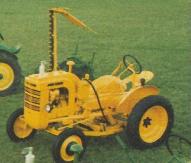Changes from the L to the LI
(1941 and later, from many sources, including parts books)
- LI uses the LA solid frame, while L uses a tube frame (however, there are numerous exceptions during production. It seems that most LIs still actually used the tube frame.)
- Two front head lights, and rear facing red marker light on left fender (only one headlight for "L")
- High speed ring gear and pinion
- Makes a 3rd gear (road gear) speed of 10 MPH
- (Copied directly from an email)
"After replacing bearings on several Ls, LAs, had to replace some on 44 LI recently. While examining ring gear and pinion gears I compared parts to LA. The cluster and drivegears are the same as LA, but the pinion gear which drives the ring gear in the back side of transmission is almost double the diameter of an L or LA, which in turn gives the LI axle more speed at low RPM. If anyone has transmission out of tractor they can take off rear 8 or 10 bolts, remove pan and can see pinion gear clearly and know by its large diameter that the transmission is LI. This is a positive way of knowing you have an LI."
- High Speed Transport Attachment
- A foot throttle used to override the governor, and provide 13-16 MPH speeds! It seems that there are no records on how much this increased the RPMs. However a couple best guesses from very knowledgeable people (not me!) say about to 1750-1800 RPM.
- Rear Tool Box
- Gasoline tank from the LA (Eight gallon, instead of six in the normal L)
- Cast iron steering box mount (later tractors, to correct problems found with original)
- Shorter front axle spindles
- This is partially true. The LI could be fitted with the normal L front axle, which had a spindle height of 11 3/4 inches. However the optional 51" wide axle was most often fitted to the LI for greater stability. This axle had shorter front spindles of 8 3/4 inches in height. Many LIs were shorter-but not all. (Thanks to a visitor of the site for the help!)
|

